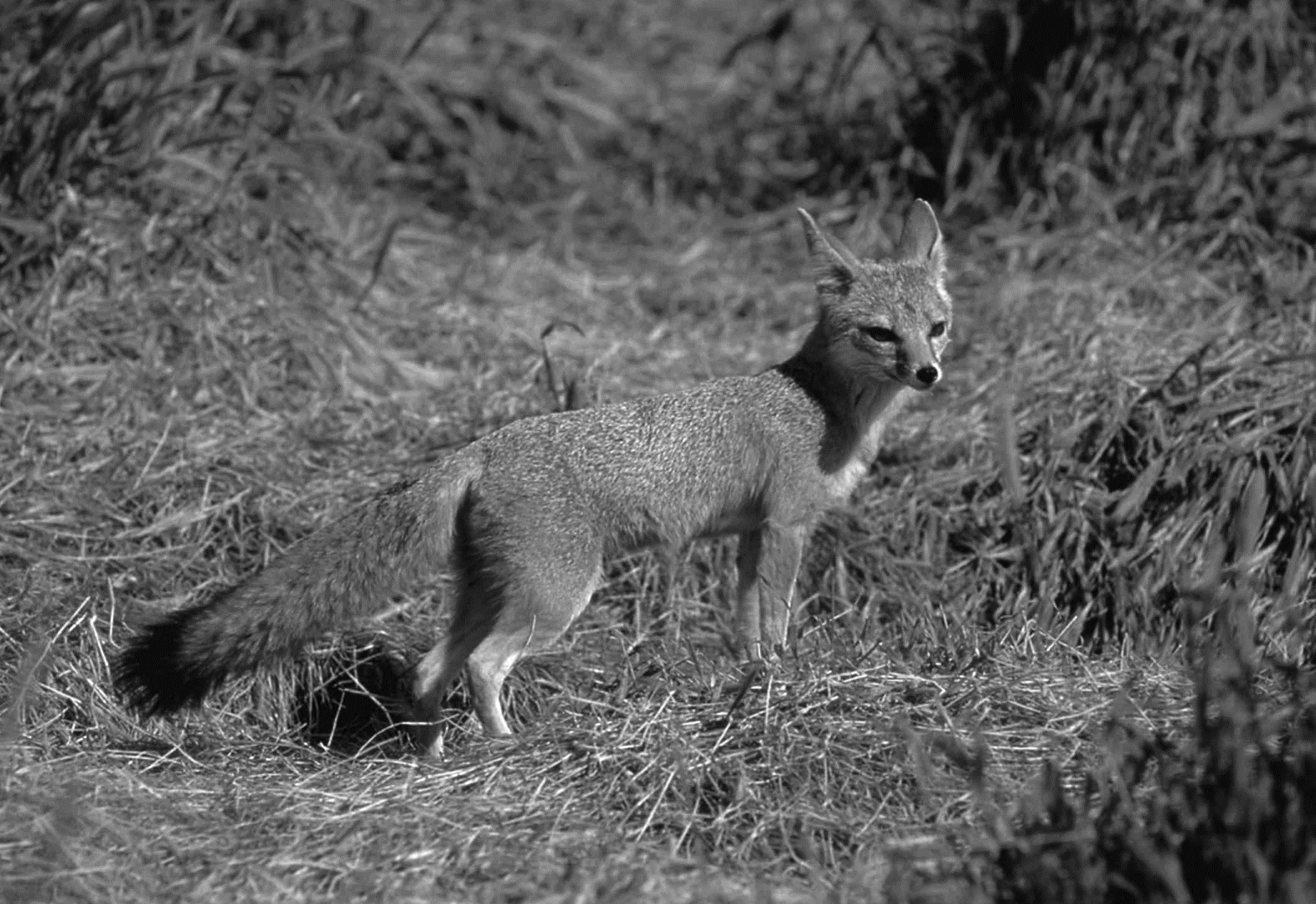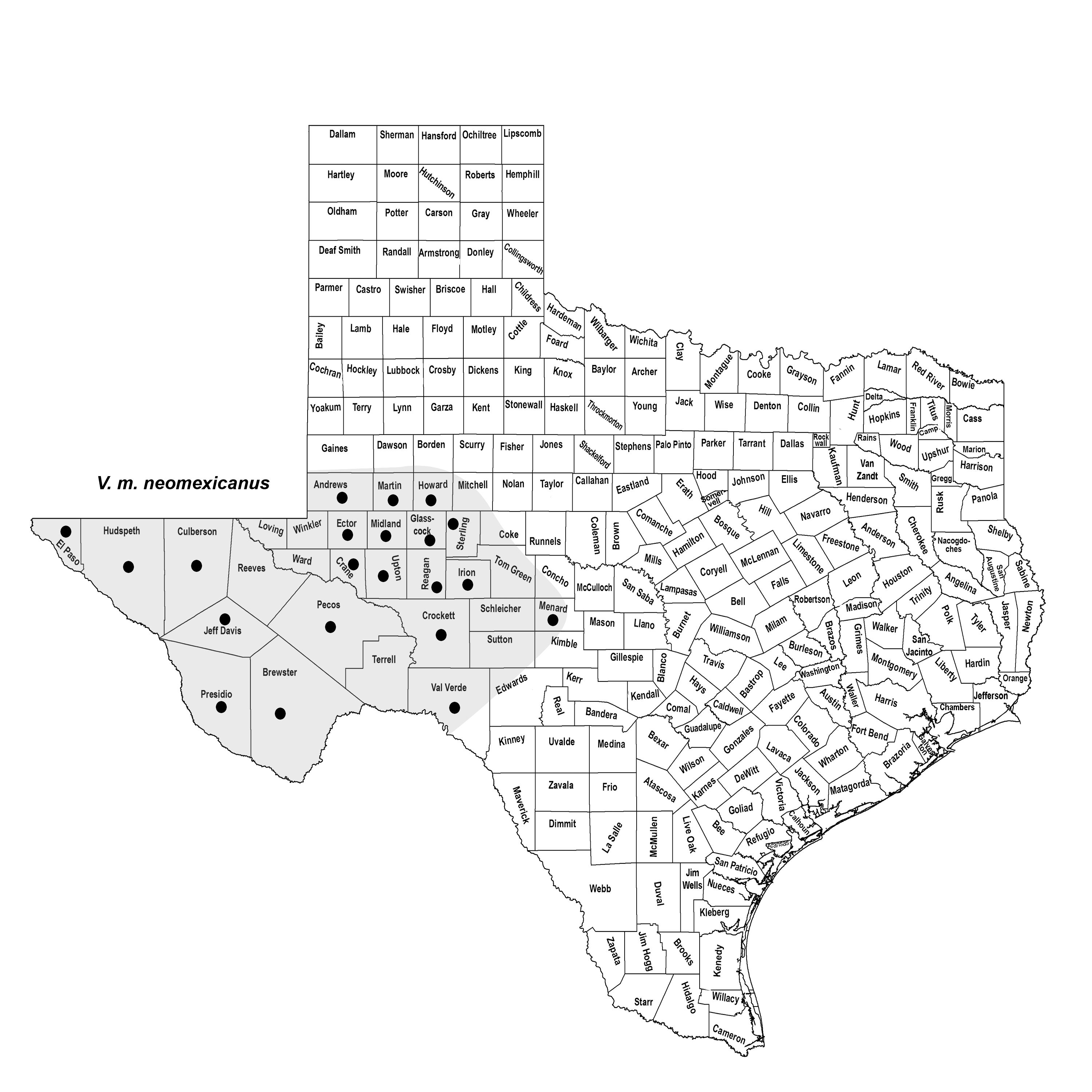KIT FOX
Vulpes macrotis Merriam 1888
Order Carnivora : Family Canidae
DESCRIPTION. One of the smallest of the American foxes; upperparts light grizzled to pale yellowish gray and lightly washed with blackish; back of ears yellowish brown; auditory bullae generally large; tail buffy gray with black tip; underparts whitish. Very similar in appearance to the swift fox (Vulpes velox), differs by having larger ears (generally >75 mm) that are set closer together at the base, head broader, and tail slightly longer. Dental formula: I 3/3, C 1/1, Pm 4/4, M 2/3 × 2 = 42. Averages for external measurement: total length, 790 mm; tail, 290 mm; hind foot, 122 mm; ear, 85 mm. Weight, 2–3 kg.

DISTRIBUTION. Known from southwestern portion of state (Trans-Pecos and Edwards Plateau) east to Menard County.

SUBSPECIES. Vulpes m. neomexicanus.
HABITS. These small foxes are about the size of an average-sized house cat and live in the open desert or grasslands. They usually den and hunt along borders of valleys, sparsely vegetated habitats on sloping hillsides, and other steppe or desert areas. They rely on speed and nearness to their dens for safety.
Kit foxes are primarily nocturnal, emerging from their dens shortly after sunset, and hunt throughout the night. Kit foxes may cover several kilometers while systematically hunting for prey but seldom venture >3 km (2 mi.) from their dens. Home ranges may overlap broadly, and foxes from different family groups hunt the same areas, although not at the same time.
The diet of kit foxes consists largely of small mammals, particularly jackrabbits and kangaroo rats. Other food items may include cottontails, small birds, and insects.
Male and female foxes establish pair bonds during October and November, during which time large family dens are used. These foxes generally are monogamous for a breeding season but the pairs are not necessarily the same from year to year. Breeding occurs from December to February, and most litters are born in February or March. Gestation is usually 49–56 days and litter size varies from four to five. Males do most of the hunting while the female (vixen) is nursing. Pups emerge at about 1 month of age and begin to hunt with the adults by 3–4 months. Pups reach adulthood by August and the family unit breaks up by October. Pups generally do not disperse far from the natal den site.
Coyotes and humans pose the greatest danger to kit foxes. Kit foxes apparently have
little fear of humans, making them susceptible to hunting and
poisoning.
POPULATION STATUS. Common. Kit foxes occur throughout much of the southwestern part of Texas but were driven to near extinction by indiscriminate poisoning campaigns directed at wolves and later coyotes. More recently, populations appear to have rebounded in limited areas.
CONSERVATION STATUS. The IUCN lists the kit fox as a species of least concern, although there is evidence to suggest that populations are declining across its range. Kit foxes do not appear on the federal or state lists of concerned species. There is a need to carefully monitor the status of this species.
REMARKS. The kit fox (Vulpes macrotis) and the swift fox (Vulpes velox) have been regarded as both one species and two species. Two independent studies have addressed this issue but have reached opposite conclusions. It appears that the kit fox is restricted to the more rugged landscape of the Edwards Plateau and Trans-Pecos area, whereas the swift fox occupies the grassland areas in the more northern regions of the state. There is some evidence that the two species may avoid competition by utilizing different habitats. The two species appear to produce hybrid offspring in areas west of Lubbock and Odessa.
From The Mammals of Texas, Seventh Edition by David J. Schmidly and Robert D. Bradley, copyright © 1994, 2004, 2016. Courtesy of the University of Texas Press.
Natural Science Research Laboratory
-
Address
Museum of Texas Tech University, 3301 4th street, Lubbock, TX 79409 -
Phone
806.742.2486 -
Email
nsrl.museum@ttu.edu

